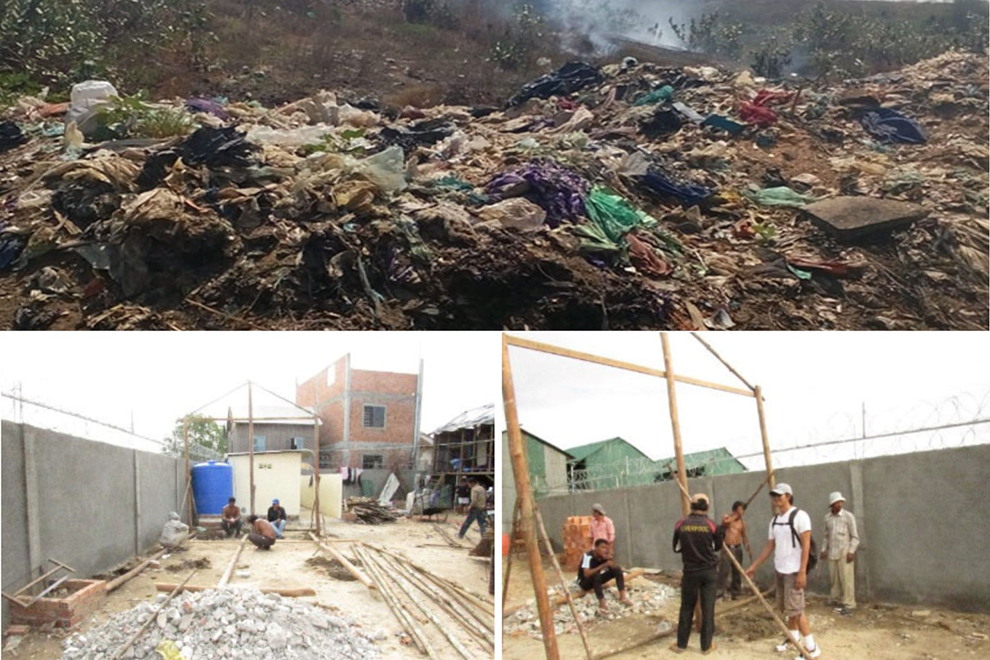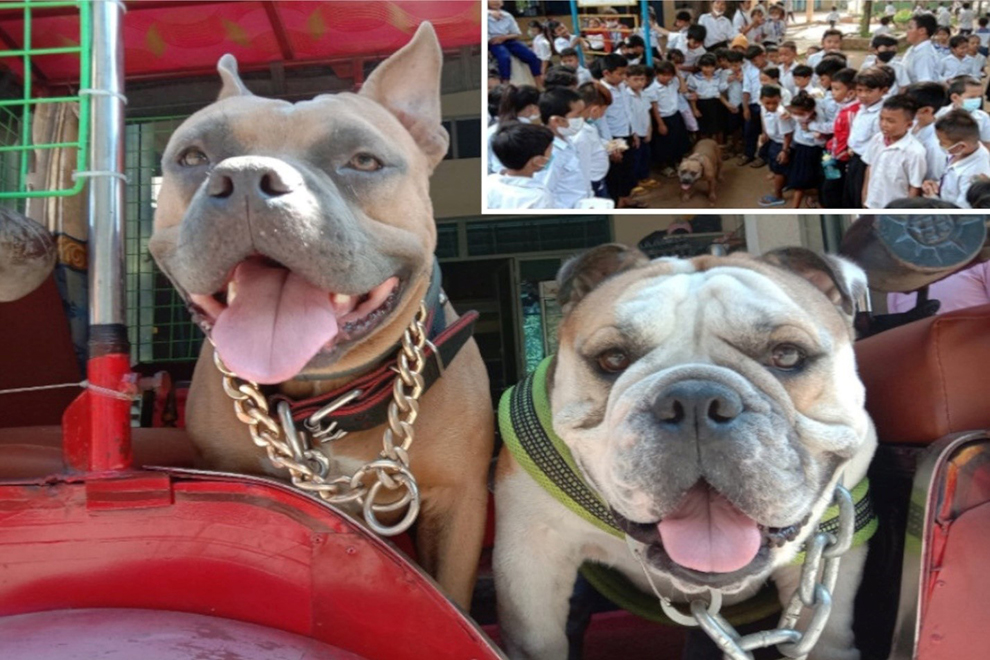August 22, 2024
PHNOM PENH – n the wake of Cambodia’s tumultuous history, two men – Darin Wyman and James Purthree – accompanied by their two dogs, Bully and Toto, dedicated themselves to bringing clean water to those in desperate need. Their organisation, Well of Life Projects Cambodia (WOLPC), has brought safe drinking water to some of the country’s most vulnerable communities.
James’s story begins in 1979, when he found himself a refugee in Thailand after the war. Growing up near the Cambodian border, he witnessed firsthand the struggles of displaced families. Driven by a desire to help, he pursued higher education in Chiang Mai, Thailand, earning both his bachelor’s and master’s degrees in theology.
In 2005, he returned to Cambodia, working with Hong Kong missionaries to support factory workers before heading back to Thailand in 2008 for further studies. It was during this period that he met Darin in 2010, a meeting that would mark the beginning of their life-changing mission.
Darin, a musician and former cruise director, felt a calling to help the people of Cambodia and realised that partnering with a local like James was essential.
James’ deep understanding of the local culture and language made him an invaluable asset, and together, they embarked on their first project in 2011 – a Christmas celebration in Prek Toul village of Meanchey district’s Stung Meanchey commune – Phnom Penh’s old city trash dump.
As Darin says, “I’d rather be up to my neck in garbage helping people in need than be a cruise director on a ship serving obnoxious, ungrateful people.”
Changing lives, one water system at a time
Their first initiative was to feed 6,000 people at a holiday party, an event that nearly ended in violence when security personnel resisted their efforts. Despite the challenges, the project was a success, and it opened their eyes to the severe water crisis in the area.
The conditions at Stung Meanchey were dire. Thousands of people lived amid mountains of garbage, without access to clean water.

TOP: Previous conditions at Ang Dong, a makeshift village in Krang Thnong commune of Phnom Penh’s Sen Sok district for those relocated from Diamond Island. Below: Well of Life builds a filtration system to provide residents of Ang Dong with potable water. PHOTOS: WOLPC/THE PHNOM PENH POST
“When we get to a place, we try to figure out what the community needs. They needed a lot! But they needed water more than anything. A lot of people had health problems, and a lot of children had diarrhoea, because they didn’t have clean water. I connected with the leaders of the community there, in the slum. There were some NGOs in the area as well, so I asked them how we could help,” James tells The Post.
“They said, ‘We don’t have this kind of project; we don’t have the money for it’. They just pointed to the money. So we prayed on how we could help these people.
“At that time, we wanted to drill a well somewhere because access to water from the city was too far away for the community, but the underground water was toxic, obviously – it was under a garbage dump,” he adds.
Darin says, “The water there was grey. It didn’t matter how deep you drilled – even 200 metres. It was still some of the most contaminated water on the planet. It’s not economical to treat that.”
The solution was to pipe it in from Phnom Penh and purify it using carbon filters. Scott Neeson, from the Cambodian Children’s Fund (CCF), provided crucial support by procuring land for their station and granting access to a free water supply. This collaborative effort enabled them to bring their plan to fruition.
“We didn’t have access to water testing in Cambodia, so we learned how to make better water. This involved adding additional carbon filters at the end of the filtration system, which made it sweeter. Now it’s easier to drink and people drink more of it. People have said to us ‘Oh, I like the taste of your water!’,” Darin says.
After the purifying process, it is stored in massive 1500-litre tanks for community use.
“In fact, for the first two years, that’s where I got my drinking water,” he adds.
“The project would not have been viable, due to expense and red tape, without Neeson’s assistance. And he gave us a place to have our distribution centre for the community,” Darin stresses while sending his profuse thanks to Neeson.
When asked about how they procured the funding to buy the system’s components – the PVC, concrete, filter components, etcetera, Darin says they spent about $6000 on the project, mostly from donations from people in Canada and America, and a small Korean church in Houston, Texas.
Expanding their reach
Encouraged by the success at Stung Meanchey, WOLPC turned its attention to Ang Dong village in Krang Thnong commune of Phnom Penh’s Sen Sok district in 2017. The area, a makeshift village for those relocated from Diamond Island, was home to nearly 30,000 people at its peak.
Each family had spaces about five-by-five metres. The need for clean water was critical.
“It’s down to around 20,000 now, but it was 30,000 then. When they got there, they had absolutely no water. That’s why we decided it would be our next project,” Darin says.
“We had to build the facility to house the distribution point,” he recalls. “It was a very serious situation. A lot of the children were ailing.”
Here again, they had a contact in another NGO, Bong Mai from Stellar Child Care Organization (SCCO). Mai was the person who informed the team that his organisation had moved from Stung Meanchey to Ang Dong and asked if WOLPC was still in the business of helping people by building water supply systems. He requested they come to look for themselves and see how they could help.
“It was a very serious situation. Again, a lot of the people, especially children, were sick and had diarrhoea. They were very far from Phnom Penh, about 12km. [Mai] took me there and introduced me to the people and the village leaders and told me about the work they were doing. Mai said they needed water, but his NGO didn’t have that kind of programme,” James says.
As he and Darin had the expertise, they took on the project, started to raise funds and worked with SCCO, which had all the connections with the government, officials and police in the community, enabling them to proceed.
The project, costing nearly $9,000, provided clean water to the entire community and drastically improved living conditions.
On a lighter note, at one point, an individual they were working with asked his congregation in Canada to bring their bottles to church as part of the fundraising effort. Within two weeks, they ended up with $1,200 worth of mostly beer bottles.
Darin mentions an interesting fact: the Japanese water treatment centre, the Phnom Penh Water Supply Authority (PPWSA), is the highest point in Phnom Penh. From there, it’s all downhill to the airport area, which means they don’t need pumps to drive the water, saving on what would normally be a huge engineering cost.
“When you see the water coming out of the main line, it’s amazing, it comes out like a pressure washer, which is fantastic,” Darin says.
Sen Sok Elementary
In 2018, WOLPC launched another project at Sen Sok Elementary School.
“They had water, but it wasn’t potable. The students had to bring it from home, which also led to more plastic usage. An NGO had previously made a filtration system for them, but it was broken and there was no money to fix it,” James says.
Their idea was to make a centre where people could come to get drinkable water, as it was a slum area. They made a deal with the principal to provide the school with clean water but in return, they would get land for free to build a public tap as part of the system, for students’ families and residents of the area.
During the Covid-19 pandemic, however, many parts of the system were stolen.
“They couldn’t steal the tanks, but anything that wasn’t bolted down got taken. They stole the cables, the pump… thieves even dug up the pipes,” Darin says.
WOLPC had been paying for the school’s water supply for two years. After the vandalism during the pandemic, they rebuilt the system in 2021. Upon reconstruction, the school took over responsibility for the water bills.
There are about 300 families living in the area, and they all now have access to free, clean water. The school serves approximately 2,500 students, and about 1,500 residents also get their water from the outside station.
The team highlights, with obvious pride, that all three systems remain in operation to the present day, providing clean water to tens of thousands.
Looking ahead
For Water System #4 the duo says there are countless options.
“You could throw a dart at the map,” as Darin says, but he mentions possibly Battambang or Kampong Speu province; they’re just waiting to raise the funds to do it.
They are also collaborating with Marie Ens, a well-known and beloved figure in Cambodia, to build an orphanage, and exploring partnerships with healthcare providers to build a hospital.
Darin met Marie in 2011. She came to Cambodia in 1957 and has over 50 years of experience founding orphanages, with five currently operational in the country.
“We can build it, but Marie knows how to run and staff it, which is the hardest part,” Darin says.
For the hospital, the group is seeking to work with Dr Mark Ambrose from Chicago, US, who runs an impact investment hospital in Cambodia providing free care to those who can’t afford treatment. They’ll turn to him for help with staffing and operational assistance.
“Our purpose is helping people in Cambodia,” James says. “If we sit down and discuss with someone and we have the same goals, same dream… Just do it!”

Darin Wyman poses for a picture with a young resident of Stung Meanchey, who now has access to healthy, clean water. PHOTOS: WOLPC/THE PHNOM PENH POST

Toto (left), a British Bulldog, and Bully, an American Staffordshire Terrier, proud members of the Well of Life Projects Cambodia crew. Inset: Students at Sen Sok Elementary School play with Bully, one of the team’s well-mannered members. PHOTOS: WOLPC/THE PHNOM PENH POST


